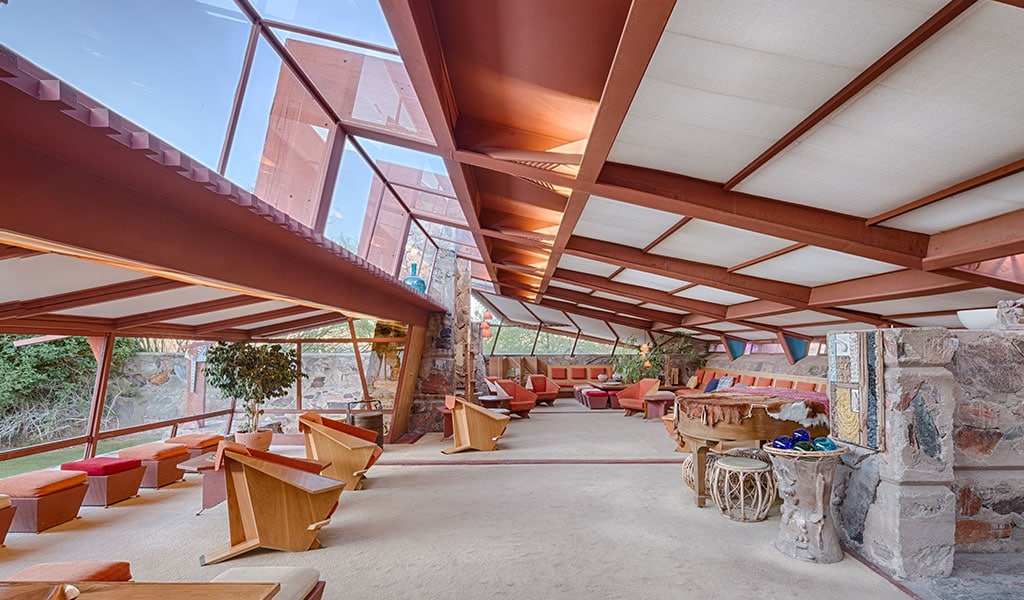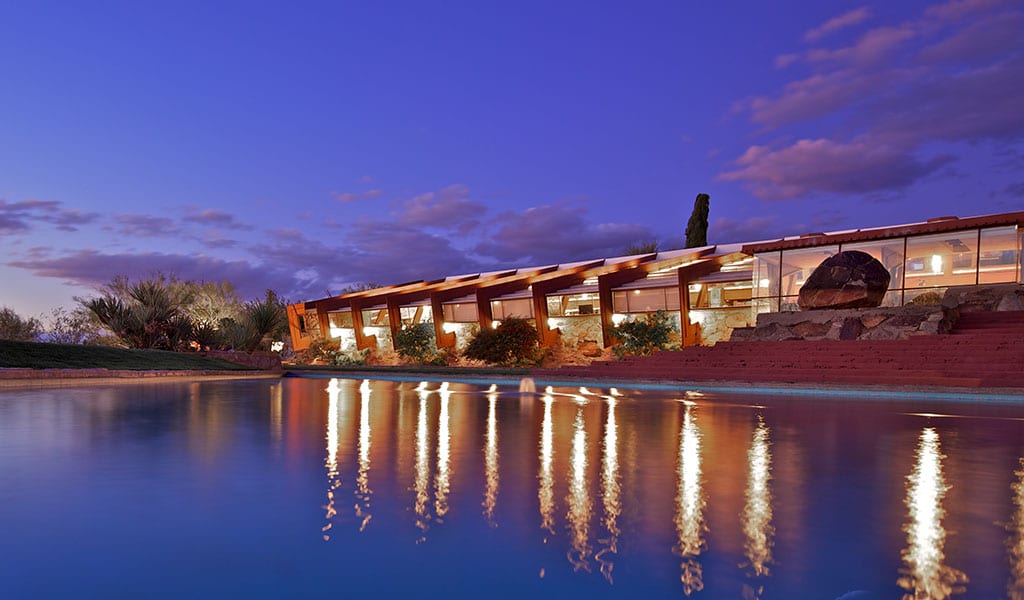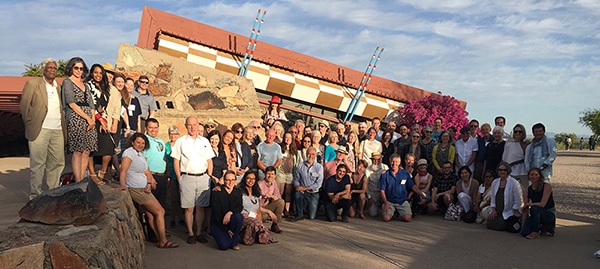Jump to:
The Architecture, Culture, and Spirituality Forum is hosting its 2019 Symposium in Taliesin West (Scottsdale, AZ), an internationally recognized icon and destination for most architects, landscape architects, and designers. Illuminated by the visionary and mystical figure of Frank Lloyd Wright, one of the most influential architects of the 20th Century, Taliesin West offers participants a place that is naturally and architecturally beautiful and inspiring. It is the perfect context where to meditate, sense, discuss, and even plan how to best harness the continuous interactions between nature, design, and spirituality. It also permits attendees to consider the little-addressed yet important legacy of FLW’s spiritual sensibility, belief, and practices vis-à-vis his work. Spending time within and without the remarkable Taliesin West will surely make participants better understand this contribution (60 years after his passing) in light of the mission of ACSF and the huge challenges facing the world today.
Although the Eleventh Annual Meeting will be held at Taliesin West (May 16-19, 2019), conference accomodations will be at the Franciscan Renewal Center, a peaceful, confortable, and friendly place only a few miles away from the symposium venue.
As in previous symposia, ACSF 11 is structured around a main topic (in this case “Continuity in/of Architecture, Culture, and Spirituality”) but also open to ideas, works, and proposals relevant to the Forum’s areas of interest. The number of attendees will be kept small to secure an atmosphere conducive to personal connections and in-depth dialogue. Optional meditation will be offered each morning and there will free time for connecting to oneself, the surrounding desert, and, of course, Taliesin West. The three keynote speakers will be: renowned architect Will Bruder, Frank Lloyd Wright scholar Michael Desmond, and internationally recognized Finnish architect Juhani Pallasmaa, the recipient of the 2019 ACSF Award for Outstanding Achievement. Part of the symposium activities will include a elective visit to Arcosanti.
Established in 2007, the Architecture, Culture, and Spirituality Forum provides an international forum for scholarship, education, practice, and advocacy regarding the cultural and spiritual significance of the built environment. ACSF believes that the design and experience of the built environment can assist the spiritual development of humanity in service of addressing the world’s most pressing issues.

n the early 1930s Frank Lloyd Wright began to use the term “continuity” as a kind of master trope for his concept of an organic architecture. For Wright the origin of this idea began when his mentor Louis Sullivan “. . . eliminated the background in his ornament in favor of an integral sense of the whole.” At its heart this action seems a simple one, but its implications can be profound. Our concept of a building, for example, is typically one of a unique and internally structured thing placed upon a site, with the site seen as a setting, a background. It is similar to the concept of a window or a door as an independently conceived thing placed in a wall, where the wall is seen as background. In each of these cases the thing, the object, is conceived according to its own rules or habits of thought before being placed in a setting. When Wright refers to the “elimination of the background” he is suggesting that we see a window and the wall in which it sits as one thing, the wall and the idea of the building as one thing, and eventually the building and the landscape as well. “Instead of many things one thing” he says of this conception, evoking a sense of richness and complexity brought into the present moment: “. . . ceilings and walls made one with floors and reinforcing each other by making them continue into one another.” By the end of the decade Wright was describing what we might see as a broad projection of this vision. “We are talking about the countryside itself developing into a type of building. . .” he wrote, “. . . in which will lie naturally, building becoming part of the countryside, building belonging there naturally with grace.”
Thus conceived, the idea of continuity presents in architectural terms a powerful way of seeing the interaction of forms and forces in the world around us that has striking parallels to the thought of Wright’s contemporary, John Dewey. Dewey referred to continuity explicitly as an expression of the idea that we are not merely in nature, we are of nature. His many works across years of teaching and writing express a desire to overcome our age-old habits of conceiving ourselves otherwise. “An organism does not live in an environment” he wrote, “it lives by means of an environment.” Its constant adapting and adjusting to the environment, and to the other creatures there, alters that environment. Because of the Darwinian scope of these relationships, he suggests that our concepts of environment must therefore describe something much more engaging than simply a place for an organism to be, they must “. . . denote the specific continuity of the surroundings with (an organism’s) own active tendencies.” In other words, the environment is not merely the background, it is the consistent and dramatic presence of all the forces of life with which we are continuous. Dewey uses this idea to undermine the many dualisms in our traditional conceptions, dualisms such as mind vs. body, theory vs. practice, means vs. ends, even matter vs. spirit, so that we can see interacting forces in motion together in continuous fields of activity in ways that enrich our conceptions of purpose.
This discourse is one that sees endurance and stability in terms of evolution and change. While being about topology instead of geometry, about the one instead of the many, the unifying nature of continuity encourages variety, transformation, and difference. It speaks to temporal as well as spatial, social, and spiritual connections even though we know that such transitions are far from easy and often demand ruptures.
Sixty years after Wright’s passing, the ACS Forum will convene in the stunning environment of Taliesin West to ask how the idea of continuity may inform our views of architecture, landscape architecture, art, craft, and urbanism. What opportunities and challenges might this discourse, and related emerging paradigms, bring to our conceptions of architecture and spirituality, to our views of culture and its apparent (dis)continuities with nature? Is a conception of continuity even possible in a cultural, physical, and increasingly virtual reality that appears ever more fragmented and discontinuous? In what ways might this, and other aspects of Wright’s legacy, inspire ACS practices, scholarship, and teaching?
Consideration: while the ACSF 11 symposium will focus on “Continuity,” we will consider submissions addressing other issues related to ACSF and include them in at least one open session during the symposium.

The ACSF 11 Symposium will take place at Taliesin West (Scottsdale, AZ), an internationally recognized icon and destination for most architects, landscape architects, and designers. Illuminated by the visionary and mystical figure of Frank Lloyd Wright, one of the most influential architects of the 20th Century, Taliesin West offers attendees a place that is naturally and architecturally beautiful and inspiring. It is the perfect context in which to meditate, sense, discuss, and even plan how to best harness the continuous interactions between nature, design, and spirituality. It also permits participants to consider the little-addressed yet important legacy of FLW’s spiritual sensibility, belief, and practices vis-à-vis his work. Spending time within and without the remarkable Taliesin West will surely make attendees better understand this contribution (60 years after his passing) in light of the mission of ACSF and the huge challenges facing the world today.
At Taliesien West we will make use of the excellent 100-seat auditorium space to conduct all our lectures and discussions. If workshops are offered (this depends on the proposals we receive), smaller rooms will be utilized. The large auditorium and small spaces have air-conditioning. We also expect to have some of our social activities and lunches outdoors as the weather should be perfect for such events. We are devoting half a morning for a guided tour of Taliesin West. Since the symposium will conduct all its activities at Taliesin West, we will have ample time and opportunity to explore, feel, and dwell in the place.
Attendees will be lodged in the nearby Franciscan Renewal Center, also referred to as “The Casa.” This is a peaceful, confortable, and friendly place offering single, double, and triple occupancy accommodations. Due to the limited number of rooms and contract conditions, ACSF 11 organizers will be booking the accommodations. As in previous symposia, priority will be given to authors/contributors. All the booking information will be made available after papers/proposals have been accepted and the final configuration of the symposium is known. But nobody should feel too concerned about finding places to stay. There are several hotels nearby, such as the Holiday Inn & Suites at Scottsdale North-Airpark, the Courtyard by Marriott at Scottsdale Salt River (near Talking Stick Resort) and the Residence Inn by Marriott (Phoenix Desert View at Mayo Clinic). However, the cost of staying at these hotels will be a bit higher than at the Franciscan Renewal Center.
In terms of getting to Taliesin West, attendees will fly to the Phoenix Sky Harbor International Airport (PHX). After looking at transportation, we concluded that using buses or rental vans is too expensive and impractical. We will do our best to coordinate so that symposium attendees car-pool. The drive from PHX to Taliesin West (located within the Scottsdale township) is 25 miles and takes about 30-40 minutes to do. Having cars (hopefully as few as possible) will also facilitate the elective trip we are planning to Arcosanti on Saturday morning (a 1:15-hour drive from Scottsdale). We utilized this car-pool transportation system when we organized the 2015 Symposium at Ghost Ranch, New Mexico and worked very well.
Symposium fee will be $300 and will cover access to all functions including the Taliesin West tour, lunches (Friday, Saturday, and Sunday), receptions /social events, and dinners (Thursday, Friday, and Saturday). This symposium fee does not include the entry fee to Arcosanti. Accommodations at the Franciscan Renewal Center will cost $118/night for single occupancy, $90/night for double occupancy, and $80/night for triple occupancy. Accommodations at the Franciscan Renewal Center include breakfast. As said earlier, staying at the other nearby hotels will be a bit more expensive unless you share the room. Last time we checked, rooms were at $124 (Holiday Inn), $129 (Courtyard at Mariott), and $189 (Residence Inn by Marriott) whether single or double occupancy.

To download a copy of our 2019 Symposium Program, click here.

To view this year’s papers and works, please click here.
Collected Abstracts of the Eleventh ACSF Symposium (May 16-19, 2019)
Edited by Julio Bermudez, Suzanne Bott, Michael J. Crosbie, and Michael Desmond (Symposium Chairs)
Note: all submissions to the symposium underwent blind-peer review by at least 3 readers. Archived 05/04/2019
Topic: Continuity in/of Architecture, Culture, and Spirituality
—
Paper Session 1: Spirit and Time (moderator: Karla Britton)
| Sarah Marie Angne Alfaro | Filling the Gap Between Heaven and Earth: One Building, Two Sides |
| Ann Marie Borys | The Continuity of Democracy as a Spiritual Tradition |
| Vellachi A. Ganesan | Light: The Ephemeral, the Ethereal, and Beyond |
| Rumiko Handa | Continuity in/of Time: Four Documentation Centers on the History of National Socialism in Germany |
| Edward Samuel |
Paper Session 2: Landscape and Place (moderator: Hyejung Chang)
| Michael J. Crosbie & Suzanne Bott | Danger and the Divine: Expressions of Protected Refuge in Continuity With Desert Lands |
| Linda Reeder | Continuity and Parkitecture: The Lookout of the Grand Canyon |
| Dennis Alan Winters | A Third Shade of Engagement with Landscape |
Paper Session 3: Architectural Education (moderator: Tom Barrie)
Project Session (moderator: Anne Mooney)
Paper Session 4: Modern Practice (moderator: Susan Jones)
| Luciana Fornari Colombo | The Continuity of the Ancient Quest for Truth, Goodness, and Beauty in the Modern Architecture of Ludwig Mies van der Rohe |
| Francesca Hankins | The Head, the Hand, and the Heart: The Intersection Between Bruce Goff and Frank Lloyd Wright’s Edaburi |
| Ben Jacks | Continuity and Boundaries in Spiritual Architectural Atmosphere: Fallingwater as Exemplar |
| Line Marschner | Possibilities For an Architecture of Continuity Through the Work of Danish Modern Architects Johannes and Inger Exner |
| Amita Sinha, Siddharth Menon, & Akhila Kosaraju | Dwelling in Shantiniketan |
Paper Session 5: Sacred Spaces (moderator: Tracey Winton)
| Brandon Ro | The Hermeneutics of Gendered Sacred Space |
| Marjorie Snipes | Multilingual Space in Shaker Design and Practice |
| Caitlin Watson | Within/Without: Louise Nevelson’s Chapel of the Good Shepherd |
Paper Session 6: Realms of Continuity (moderator: Michael Desmond)
| Prem Chandavarkar | Notes on the Source of Continuity in Architecture |
| Norman Crowe | Continuity and Discontinuity in the Cityscape |
| Robert Hermanson | Continuo and Change |
Workshops
| Sarika Bajoria | Becoming Mindful Architect |
| Roberto Chiotti | ACSF Declaration of Transcendent Human Habitat — Next Steps |
| William Tripp | Threads of Continuity: The Future of Architecture |
Three Keynote Lectures
| Michael Desmond | Prairies as Prelude: Frank Lloyd Wright and the Idea of Continuity |
| Will Bruder | From HEAD to HEART to HAND |
| Juhani Pallasmaa (2019 ACSF Outstanding Achievement Awardee) |
THOUGHT AND FORM: writing and drawing architecture |
To download a copy of our 2019 Symposium participants, click here.

Most of the ACSF 11 symposium participants at Taliesin West, in one great photo!
(in alphabetical order by last name)
Julio Bermudez (co-chair) | The Catholic University of America | email: bermudez@cua.edu
Suzanne E. Bott (co-chair) | University of Arizona | email: suzbott@hotmail.com
Michael J. Crosbie (co-chair) | University of Hartford | email: Crosbie@hartford.edu
Michael Desmond (co-chair) | Louisiana State University | email:mdesmond@lsu.edu
Stuart I. Graff | Frank Lloyd Wright Foundation
The Board of ACSF recognizes and thanks the Frank Lloyd Foundation for being a partner in the organization and support of its Eleventh Annual Symposium to take at Taliesin West in May 2019.